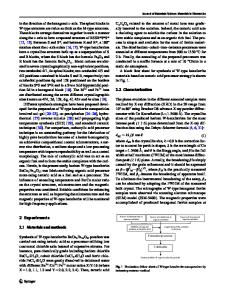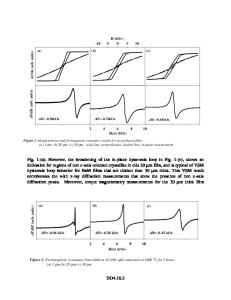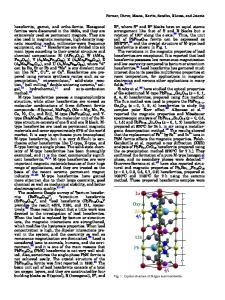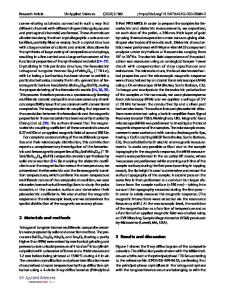Improved structural and magnetic properties of a non-stoichiometry Ba:Fe ratio of barium hexaferrite film
- PDF / 2,374,801 Bytes
- 8 Pages / 595.276 x 790.866 pts Page_size
- 66 Downloads / 342 Views
Improved structural and magnetic properties of a non‑stoichiometry Ba:Fe ratio of barium hexaferrite film N. B. Ibrahim1 · Y. Noratiqah1 · M. F. A. Jailani1 · E. R. Iruthayaraj1 Received: 17 July 2020 / Accepted: 13 October 2020 © Springer-Verlag GmbH Germany, part of Springer Nature 2020
Abstract In this study, barium hexaferrite film with different Ba:Fe molar ratios (1:2, 1:4, 1:6, 1:8, 1:10 and 1:12) has been synthesized by a sol–gel method and annealed at a temperature of 800 °C in the air. The structural, morphological and magnetic properties of the films have been analyzed by an X-ray diffractometer, a field emission scanning electron microscope and a vibrating sample magnetometer, respectively. The structural analysis revealed that the film with Ba:Fe ratio of 1:4, 1:6, 1:8 and 1:10 crystallized into single phase of BaFe12O19. The morphology study showed that a film with different Ba:Fe ratios has different grain size and shapes. The magnetic measurement at room temperature showed that the film with Ba:Fe ratio of 1:10 has the highest coercivity, Hc value and the film with Ba:Fe ratio of 1:4 exhibits the highest magnetization saturation, Ms value. Because of their high coercivity values, all of the single-phase films are suitable for permanent magnet and data storage applications. Keywords Barium hexaferrite · Sol–gel · Thin film · Hexagonal
1 Introduction Barium hexaferrite (BaM) is one of the famous ferrite materials that receives a lot of attention among researchers, because of its unique properties i.e. having a high magnetocrystalline anisotropy, a high saturation magnetization, good chemical stability and resistance to corrosion [1, 2]. Barium hexaferrite is also a good candidate to replace rareearth based magnetic materials because of its lower production cost compared to the rare-earth based magnetic materials [3, 4]. Besides, this material also beneficial for certain applications such as magnetic recording, microwave devices and in automotive sectors [5–7]. As reported, there are many techniques that can be used to prepare barium hexaferrite film, i.e. magnetron-sputtering deposition [8], sol–gel hydrothermal method [9] and sol–gel method [5, 6]. Among these techniques, the sol–gel method is the most favorable because of its capability in producing a high homogenity films, despite of its simple and low cost preparation technique [6, * N. B. Ibrahim [email protected] 1
Department of Applied Physics, Faculty of Science and Technology, Universiti Kebangsaan Malaysia, 43600 Bangi, Selangor, Malaysia
11]. However, one of the main problem in barium hexaferrite film production using a sol–gel method is, the presence of Fe2O3 phase that always forms along with BaM phase and its existence is known to affect the structural and magnetic properties of BaM films [8–10]. The formation of Fe2O3 phase is due to three reasons: first, the difference of solubility rate between Ba and Fe in the solvent; where Fe is easily dissolved in any solvent compares to Ba [13], thus affecting the homogeneity of the
Data Loading...











